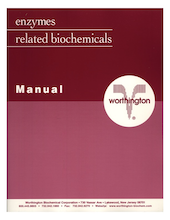For our international customers, please be advised that orders cannot be placed through our website by customers in countries with International Distributor representation.
Enzyme Manual
The Worthington Enzyme Manual contains technical information on enzymes including molecular weight, composition, activators, specificity, inhibitors, stability, assay method, optimum pH, ionic effects, temperature effects, extinction coefficient, and isoelectric point, as well as applications and extensive references.

Actin is a protein that functions in the contractile system of skeletal muscle, where it is found in the thin filaments. In muscle, fibrous actin (F-actin) is a helical polymer of a globular…
Adenosine deaminase catalyzes the irreversible deamination of 2'-deoxyadenosine and adenosine to deoxyinosine and inosine. It is found in a wide variety of prokaryotes and eukaryotes in different…
Serum albumin is the most abundant protein of the circulatory system and functions to bind and transport long chain fatty acid anions, to remove bilirubin, and as back-up transport of thyroid and…
Alcohol dehydrogenase (ADH), part of the oxidoreductase family, catalyzes the oxidation of alcohols, using NAD+ or NADP+ as the electron acceptor (White and White 1997). The reaction is reversible…
Fructose-biphosphate aldolase (ALD) catalyzes a key reaction in glycolysis and energy production:
Aldolase is present in all animal and plant tissue, and in most microorganisms. Class I aldolase…
D-amino acid oxidase (DAAO) is an oxidoreductase that oxidatively deaminates D-amino acids to the corresponding alpha-keto acid. DAAO is a flavoenzyme, containing 1 mole of FAD per monomer.
L-amino acid oxidase (LAAO) catalyzes the oxidative deamination of a number of L-amino acids, predominantly hydrophobic and aromatic L-amino acids. LAAO represents approximately 30% of the total…
Porcine pancreatic alpha-amylase (PPA) acts upon large linear carbohydrate polymers at internal bonds. The hydrolytic products have alpha-configuration. alpha-Amylase activity is present in all…
β-Amylase is an exoenzyme that releases successive maltose units from the nonreducing end of a polysaccharide chain by hydrolysis of α-1,4-glucan linkages. The shortest normal saccharide attacked is…
Arginase is a hydrolase present in many tissues and organs that catalyzes the following reaction:
The enzyme participates in the Krebs-Henseleit urea cycle. It is most highly concentrated in…
Asparaginase catalyzes the hydrolysis of L-asparagine to produce L-aspartic acid and ammonia. Bacterial type L-asparaginases are classified into subtypes I and II, which is defined by their intra- or…
Aspartate aminotransferase (AspAT) is a key enzyme of amino acid metabolism that catalyzes the reversible transfer of the amine group from L-aspartate to 2-oxoglutarate. In mammalian tissues the…
Avidin is a glycoprotein consisting of four identical subunits. It is a minor constituent of the egg white of reptiles, amphibians, and birds. In the chicken, it is synthesized in the oviduct in…
Agarases are glycoside hydrolases that catalyze the hydrolysis of agar. Agarases are primarily found in marine organisms (Fu and Kim 2010), with microorganisms being the primary sources for agarase…
Carbonic anhydrase (CA) catalyzes the reversible hydration and dehydration reactions of CO2/H2CO3. CAs are widespread in nature, being found in animals, plants, and certain bacteria. Sixteen isozymes…
Carboxypeptidase A (CPDA) is a pancreatic metalloexopeptidase that hydrolyzes the peptide bond adjacent to the C-terminal end of a polypeptide chain.
Carboxypeptidase B (CPDB) is a metallocarboxypeptidase that catalyzes the hydrolysis of the basic amino acids, lysine, arginine, and ornithine from the C-terminal position of polypeptides:
Peptidyl-…
Carboxypeptidase Y (CPDY) is a glycoprotein exopeptidase of the acid and serine class.
The caseins are a group of proteins whose hydrophobicity and relatively high charge differentiate them from most other proteins. alphas1-Casein is the major protein fraction of bovine milk. A…



